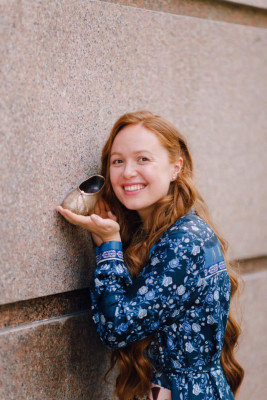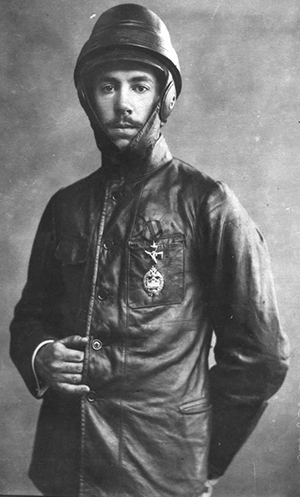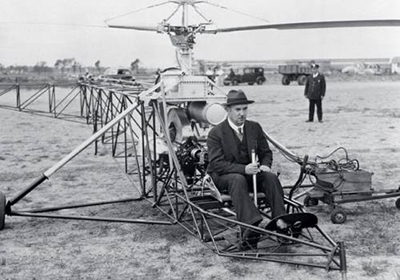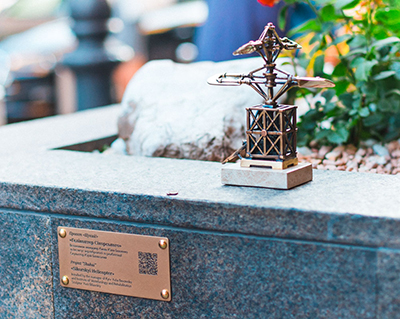Inspirational Kyiv stories: Igor Sikorsky
- 16.05.2020
- Corporate Blog & News

Today, when all of us have more time for our beloved affairs and interesting discoveries, Premier Hotels and Resorts offers you to feel the spirit of Kyiv and inspired with the stories of the legendary Kyiv native persons.
 Yulia Bevzenko, manager of Kyiv, tour guide and author of the Shukay project has prepared 5 inspirational Kyiv stories especially for Premier.
Yulia Bevzenko, manager of Kyiv, tour guide and author of the Shukay project has prepared 5 inspirational Kyiv stories especially for Premier.
The story of my last inspiration began in Uzhgorod in 2017. In all the cities and countries that I visit, I take individual tours with guides. In Uzhgorod, we had an excursion with Victor Opalenik and at one point he showed us a tiny sculpture of the Statue of Liberty. Just a small sculpture was attached on the railing of the embankment and Victor told us that there are already more than 20 such sculptures in the city and all of them are somehow connected with Uzhgorod, Ukraine and Hungary. I did not need anything else, neither a tour, nor a house, nor facts; I wanted to find all the sculptures. Finding each, I was happy and jumped like a child. Having returned to Kyiv, I realized that it would be great if there was such a project in Kyiv. Only so that these sculptures tell the story of Kyiv. Thought and forgot.
So the project “Shukay!” was born, because I simply could not take and forget about such an idea. In two years, we installed 24 mini-sculptures and on April 10 the twenty-fifth (it was an online opening).
Creating the project “Shukay!”, I realized that I needed new skills and new strengths. I needed to be uncompromising, faith in my idea, a little crazy, industriousness and many stories about Kyiv. Every time it was difficult for me, I remembered the stories of those people about whom I will tell today. So, get acquainted, Igor Sikorsky.
II Story
IGOR SIKORSKY
 Igor Sikorsky was influenced by the book. The book of the writer Jules Verne — «Robur the Conqueror». This book will become a guiding star for him and thanks to it he had a dream to create a flying tool with a propeller — a helicopter.
Igor Sikorsky was influenced by the book. The book of the writer Jules Verne — «Robur the Conqueror». This book will become a guiding star for him and thanks to it he had a dream to create a flying tool with a propeller — a helicopter.
The family planned that he will be a naval officer, but Igor Sikorsky did not have good health, when the weather changed, his nose could bleed, and even slight hypothermia led to protracted illnesses. And instead of military textbooks, the student chose the theory of mechanics. Immediately after graduating from the Marine Corps in 1907, Sikorsky entered the Kiev Polytechnic Institute. Already in 1908, student of the KPI Igor Sikorsky designed and built his first helicopter, which never took off.
In the same year in Paris, engineers Louis Breguet and Paul Corno designed the first helicopter models. They managed to raise the machines a few meters above the ground, but they stopped there.
Upon returning to Kiev, Sikorsky abandoned his studies at the institute and spent a lot of time in a workshop in the yard of his parents' house on Yaroslavyv Val. And after a couple of months he asked his parents for money for a trip to France.
He wanted to construct an engine on the basis of which he could build a real helicopter. The family lived in abundance, and at the family council they decided to support their son.
The whole next year the young engineer without his education built his helicopter in the yard. However, he never managed to surpass the French designers - the Sikorsky helicopter with a heavy engine barely took off a few centimeters. The inventor threw the idea and decided to take up airplanes.
On a large wasteland on Kurenivka, that time suburb of Kiev, Sikorsky and his friends built a hangar in which they built the first airplane. The flight took place on June 3, 1910. The machine climbed 1.5 m and flew 200 m in 12 seconds.
The team did not stop there. A year later, Sikorsky took the first two passengers aboard his airplane. And so on, it begins to develop at cosmic speed.
A month after this success, the designer nearly crashed. With friends and an airplane, he went to the Bila Tserkva for a demonstration flight. Rising in front of the public to a height of 50 m, the Sikorsky airplane stalled. The pilot miraculously found a landing site, orderly damaging the machine. When examining the engine, it turned out that a mosquito got into the nozzle - the carburetor part responsible for the dosage of fuel.
After that, Sikorsky concluded:
“For reliable movement over air over long distances, you need to use airplanes with several engines and it is necessary that there are several people inside machine, each of them must carry out his specific business.”
And when he already worked as a contract designer in St. Petersburg, he came up with the idea of a multi-engine heavy aircraft.
Sikorsky lifted all his engineers out of bed. Sleepy, they came to his house, and there in the morning they made a plan for the construction of a new aircraft, under champagne. Six months later, a machine with four engines, a closed cabin and seats for passengers was ready for testing.
Soon 16 people and a dog took to the air on it - together this company weighed 1.290 kg. Sikorsky was the pilot. He named his plane Ilya Muromets.
And then the farthest passenger flight in the world took place on an airplane on the route Petersburg-Kiev with just one landing.
The revolution in Russia suspended the work of Sikorsky. It so happened that most of the emigrants from the Russian Empire who were engaged in aircraft construction in their homeland gathered at that time in New York. They called Sikorsky into the country of great opportunities.
However, New York was in hurry to invest in aviation, which was still considered a hobby for desperate eccentrics. Sikorsky had to change regularly housing for cheaper. He tried to spend no more than 80 cents a day for food, and therefore mainly coffee and beans were in his diet. At one time, Sikorsky even taught mathematics at a school for children of Russian emigrants.
He lived on the idea of creating airplanes and managed to get money in a completely unexpected way. Sikorsky's passion for music helped. Almost for the last dollars he bought a ticket for the concert of the brilliant composer and pianist Sergei Rachmaninov. At the end of the evening I went backstage to thank the maestro for great music. He, of course, heard about Sikorsky, invited him to drink tea together. The aircraft designer spoke about his difficulties. Rachmaninov in response took out his entire fee - five thousand dollars - from his pocket and gave it to his interlocutor, so that he would raise his own company. Then, in the early 1920s, it was a very large amount. Sikorsky later returned it to Rachmaninov with extra.
 In 1923, together with friends, he registered the company Sikorsky Aircraft Corporation.
In 1923, together with friends, he registered the company Sikorsky Aircraft Corporation.
Six people worked in the office. Sikorsky's first American tool was scissors for cutting metal plates, which they managed to make from a bumper, bought at a landfill for 50 cents. Subsequently, the landfill will become the main source of materials for the company. Corner beams from beds were especially appreciated - with their help any parts of the plane were well attached.
By mid-summer 1924, Sikorsky built a new S-29A, which lacked only engines. The designer looked after two decommissioned but repaired engines for $ 2.5 thousand. There was no money, and he convened shareholders for a meeting. Few believed in the success of the venture, but more than fifty people were crammed into the Long Island hangar. The president of the company locked the door from the inside with a key and said: "Until we collect the necessary amount, no one will go anywhere." When the indignation of the guests abated, Sikorsky once again calmly assured that everything would work out. After a couple of hours, he opened the door - they raised money.
The demonstration of the aircraft was successful, and the company received the first order - to transport two pianos from Rooseveltfield to Washington. The first $500 was earned on this.
- He rose to the sky in Kiev, where he set the first world records.
- He began mass production of airplanes, at that time the capital of the Russian Empire. His aircraft became widespread in the United States.
- Now Sikorsky helicopters are in service with the US Air Force and the security services of American presidents, starting with Dwight Eisenhower.
 In the project "Shukay!" we installed a Sikorsky helicopter. You can look it on Yaroslaviv Val Street, 22. The sign is next: rub me and you will have a dream.
In the project "Shukay!" we installed a Sikorsky helicopter. You can look it on Yaroslaviv Val Street, 22. The sign is next: rub me and you will have a dream.
The conclusion from this story is the following: do not give up your dreams.
